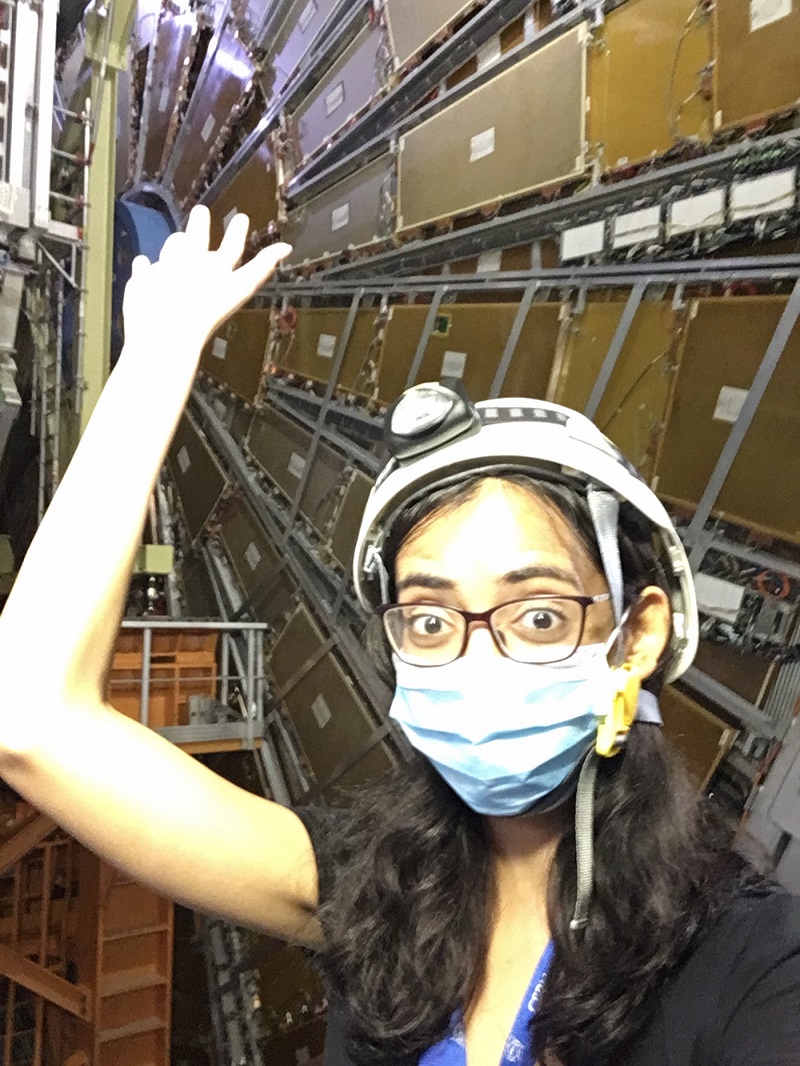My CERN Internship & visit to the ATLAS experiment
My CERN Internship & visit to the ATLAS experiment
The thrill of being on the highest point of an underground accelerator was surreal.
Meet Chetna, CERN Intern from India who tells us about her visit to the CERN ATLAS experiment: "like the feeling you get standing on the top of a mountain.".
(Note: Chetna visited ATLAS during her internship at CERN with the Social Media team, as part of a live event. Owing to the COVID-19 pandemic, visiting CERN is currently not possible. However you can take very exciting virtual visits in the meantime, from the comfort of your own home! Thanks for understanding.)
I clenched my phone tightly as I stood on the topmost floor of the biggest particle accelerator in the world, the Large Hadron Collider (LHC).
In truth, the LHC is so massive (roughly 27 kilometres in circumference), that it is divided into four locations hosting detectors where the beams are collided to find new particles. Out of the four locations, I got an opportunity to visit the largest particle detector, ATLAS, on my fifth day at CERN as a trainee.
Right here on July 4th, 2012, ATLAS along with the CMS detector announced that they had each observed a new particle, what is now commonly known as the "God particle" or Higgs Boson. But did you ever wonder why the Higgs Boson was called the God particle?
Because it was simply so goddamn hard to find!
“God” or the “most wanted”, it is a particle that physicists have certainly been desperate to find. The publisher wouldn’t let us call it the Goddamn Particle, though that might be a more appropriate title," said Jim Baggott, the author of Higgs: The Invention and Discovery of the ‘God Particle'.
The discovery of Higgs Boson explained a fundamental truth and happened in a small Swiss town called Meyrin, where I live today.
"Countless Higgs boson particles make up an invisible force throughout the universe that allows other particles to bind together and form things, like stars and planets and Donald Trump's hair," said Rex Huppke in his article, God Particle for Dummies.
I was present with my colleagues of the CERN communications social media team to do a live CERN Instagram session for nearly half a million people who followed CERN online.
Though my team had already been to ATLAS a couple of times before, for me, everything felt new. Like the feeling you get before taking an exam. Like the feeling you get standing on the top of a mountain. Like the feeling you get when falling in love.
However, to my team’s surprise, it was the first time that we were permitted to go to the topmost floor of ATLAS, unlike the usual scenarios where visitors are only taken up to as high as the fourth floor.
I would have said we were on the “top of the world” but actually, we were 100 metres deep underground, where the ATLAS cavern was built. Yet, the thrill of being on the highest point of an underground accelerator was surreal.
“The 27-kilometre accelerator is built underground not only because it was cheaper to excavate a tunnel compared to acquire the corresponding land at the surface, but also because that way, there is minimum impact on the landscape,” said Dr Rachel Avramidou, a researcher at CERN.
To lead us through the ATLAS experiment, Dr Manuella Vincter, a Physics professor at Carleton University in Canada and a member of ATLAS since 1998, joined my team for a live interview. Unlike me and my team handling the video equipment, she was unperturbed by the noise of the loud detector around her and still managed to tell us the stories about the particle accelerators effortlessly.
“But where does the collision of particles occur exactly?” I asked.
“Right here in the middle of the room,” she pointed to what appeared to be a large box that could fit perhaps 10,000 washing machines. “But the collisions are stopped currently due to Long Shutdown 2 to upgrade the LHC.”
“But aren’t the particles supposed to collide all the time?”
“Yes, they do. These particles are collided for three years continuously, except for around two months over the Christmas holidays. Then for the next two years, the work is stopped for maintenance,” she explained.
It was certainly understandable why the maintenance period of the largest machine in the world would last two years.
As I entered the elevator to wrap up one of the most exciting experiences of my life, Dr Vincter added, “Do you know what’s most special about this place? In times of emergency, unlike normal situations, this elevator is the safest place underground. It is fire-resistant, and always has the right pressure maintained.”
After a nearly one-minute long elevator ride to reach the ground level, you could detect a smile on my face despite the mask.
